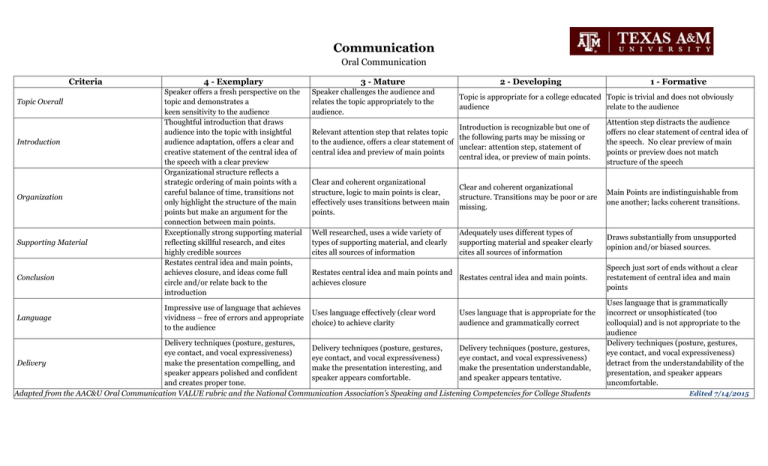Communication Oral Communication Criteria
advertisement

Communication Oral Communication Criteria Topic Overall Introduction Organization Supporting Material Conclusion Language 4 - Exemplary Speaker offers a fresh perspective on the topic and demonstrates a keen sensitivity to the audience Thoughtful introduction that draws audience into the topic with insightful audience adaptation, offers a clear and creative statement of the central idea of the speech with a clear preview Organizational structure reflects a strategic ordering of main points with a careful balance of time, transitions not only highlight the structure of the main points but make an argument for the connection between main points. Exceptionally strong supporting material reflecting skillful research, and cites highly credible sources Restates central idea and main points, achieves closure, and ideas come full circle and/or relate back to the introduction Impressive use of language that achieves vividness – free of errors and appropriate to the audience 3 - Mature Speaker challenges the audience and relates the topic appropriately to the audience. 2 - Developing 1 - Formative Topic is appropriate for a college educated Topic is trivial and does not obviously audience relate to the audience Introduction is recognizable but one of Relevant attention step that relates topic the following parts may be missing or to the audience, offers a clear statement of unclear: attention step, statement of central idea and preview of main points central idea, or preview of main points. Attention step distracts the audience offers no clear statement of central idea of the speech. No clear preview of main points or preview does not match structure of the speech Clear and coherent organizational structure, logic to main points is clear, effectively uses transitions between main points. Clear and coherent organizational structure. Transitions may be poor or are missing. Main Points are indistinguishable from one another; lacks coherent transitions. Well researched, uses a wide variety of types of supporting material, and clearly cites all sources of information Adequately uses different types of supporting material and speaker clearly cites all sources of information Draws substantially from unsupported opinion and/or biased sources. Restates central idea and main points and Restates central idea and main points. achieves closure Uses language effectively (clear word choice) to achieve clarity Uses language that is appropriate for the audience and grammatically correct Delivery techniques (posture, gestures, Delivery techniques (posture, gestures, Delivery techniques (posture, gestures, eye contact, and vocal expressiveness) eye contact, and vocal expressiveness) eye contact, and vocal expressiveness) Delivery make the presentation compelling, and make the presentation interesting, and make the presentation understandable, speaker appears polished and confident speaker appears comfortable. and speaker appears tentative. and creates proper tone. Adapted from the AAC&U Oral Communication VALUE rubric and the National Communication Association’s Speaking and Listening Competencies for College Students Speech just sort of ends without a clear restatement of central idea and main points Uses language that is grammatically incorrect or unsophisticated (too colloquial) and is not appropriate to the audience Delivery techniques (posture, gestures, eye contact, and vocal expressiveness) detract from the understandability of the presentation, and speaker appears uncomfortable. Edited 7/14/2015 Communication Courses in the American History category focus on the consideration of past events and ideas relative to the United States, and involve the interaction among individuals, communities, states, the nation, and the world. Core Objectives Critical Thinking Skills: To include creative thinking, innovation, inquiry, and analysis, evaluation and synthesis of information Communication Skills: To include effective development, interpretation and expression of ideas through written, oral and visual communication Teamwork: To include the ability to consider different points of view and to work effectively with others to support a shared purpose or goal Personal Responsibility: To include the ability to connect choices, actions and consequences to ethical decision-making Definition: Oral communication is a prepared, purposeful presentation designed to increase knowledge, to foster understanding, or to promote change in an audience members’ attitudes, values, beliefs, or behaviors. Framing language: Oral communication takes many forms. This rubric is specifically designed to evaluate oral presentations of a single speaker and is best applied to live or video-recorded presentations. This rubric best applies to presentations of sufficient length such that a central message is conveyed, supported by one or more forms of supporting materials and includes a purposeful organization. The rubric can be applied to panel or group presentations, but will work best if each speaker is evaluated separately. This rubric will not be readily applied to a question and answer session that is not also structured into a presentation.



